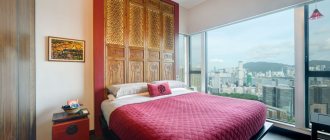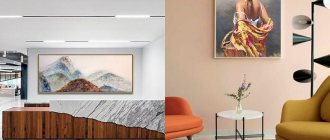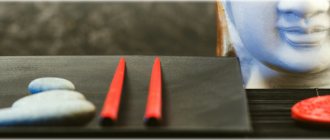With the increasing availability of the Internet and its resources, representatives of various professions began to do part of their main work not somewhere in the office, but right at home. Any successful person, be it a politician, businessman, writer, designer or architect, must have a separate room in his home - an office. This is a room that fully meets the needs of the owner and is equipped for the most comfortable and productive performance of certain activities.
Color in the interior of the office
The color design of a home office is a purely individual matter, directly depending on the taste preferences of the owner and the nature of his activities. The color design is determined not only by the characteristics of a particular interior style, but also by the psychological influence of the desired palette on a person. By choosing the right shades, you can create ideal conditions for both complex, painstaking work and creative activity.
How wall color affects the work environment
Any shade affects a person’s emotional state and performance. Therefore, you need to choose it very carefully, taking into account a number of nuances and features.
White
This color is perfect for small spaces. It helps to get in the mood for work and constantly keeps a person in good shape. This color is perfect for finishing walls and ceilings. At the same time, it can be safely combined with other shades. The most suitable options include gray, green, brown tones.
The white color itself has many variations - from frosty snow to milky. Thanks to this, designers can use it to realize their wildest fantasies.
Beige
This color is versatile. It has a mild calming effect, giving a feeling of stability and security. This shade can be used not only for decorating walls, but also for finishing the floor. At the same time, it is allowed to use bright elements in the interior that will not overload the overall design.
In combination with white panels, the beige shade helps to emphasize the sophistication and beauty of the furniture without overloading the space. A very successful combination can be achieved if you combine beige with gray or blue. This will help make the room truly luxurious.
Green
Green, a color that calms the nerves, is ideal for office decoration. The use of this shade has been proven to reduce sensitivity to noise, increase productivity and help cope with eye strain.
To decorate an office space, it is permissible to use a variety of types of greenery - shades of apple, forest moss or lime.
As a complement to this background, it is allowed to use white and gray interior elements. Woody brown tones would be a good solution.
See also
Technology for applying pearlescent paint and how to make it yourself
Yellow
This color saturates a person with energy. It has an invigorating effect and increases intelligence. It is important to consider that constant stimulation of the nervous system can be tiring. Therefore, when decorating office spaces, it is worth using not too bright variations of yellow.
Gray or brown shades are suitable as additions to this palette. An equally good solution would be to use soft tones of green.
Orange
This color looks very cheerful. Psychologists say that it helps improve overall tone and stimulates the imagination. This shade is perfect for creative individuals who constantly need to generate creative ideas.
Expert opinion
Zakharova Irina Yurievna
Cleaning professional with 15 years of experience. Our best expert.
Ask a Question
In offices, this rich color should be diluted with a more neutral palette.
As additions, you can safely use white, gray, wood tones. The orange color scheme should be used to decorate cold northern rooms. On the south side this color will not look very appropriate.
Blue or cyan
The blue tint increases productivity and activates thought processes. With its help, it is possible to gently calm the nervous system and create a strict atmosphere.
Blue tones are perfect for people whose work requires high concentration and precision. However, the use of blue tones for office decoration requires extreme caution. In this case, lighting is of particular importance. Properly selected lamps will help avoid attacks of melancholy and depression.
Grey
This shade is considered the true embodiment of minimalism and neatness. It is ideal for decorating office spaces.
Gray color is distinguished by aristocratic restraint and calm. Thanks to this, it allows you to tune in to achieving your goals and increase concentration. This allows people to successfully perform the most difficult jobs. As additions to this palette, it is worth using white or orange shades. An equally good solution would be greenish tones.
Brown tones
Such shades evoke strong associations with stability and material well-being. The wood-brown palette is ideal for decorating office spaces.
See also
Technical characteristics of polyvinyl acetate water-based paint
All shades of this spectrum have a calming effect on people and help them concentrate on making meaningful decisions. Modern interiors often use a striking contrast between a light background and dark brown furniture.
Violet
This shade helps to awaken imagination. Dosed use of this color is suitable for decorating the work area of representatives of creative professions. It is best to combine this color with white. A good combination is obtained with ashy shades.
Red or pink
Using red or pink tones to decorate work spaces is not considered the best option. The red palette looks very active. With prolonged exposure to a person, it can cause causeless irritability.
At the same time, the pink shade symbolizes dreaminess and romance. Such feelings do not increase productivity at all. However, people who love these shades can use them. However, this must be done in doses.
Colors for the office and their variations
Below are some basic guidelines for using different colors in offices:
- White. It will visually enlarge the space, provide a feeling of efficiency and severity, but to a significant extent it becomes faceless and can evoke sadness. It is better to combine it with dark tones or add bright details - red, green, blue.
- Brown. This color evokes a feeling of security, but is not suitable for every office. Where clerks, accountants, economists sit, and a lot of paperwork is processed, brown walls can cause depression. On the contrary, it will look perfect in the investigator’s office. Brown is always popular with visitors and those employees who are not in the office all the time.
- Blue. Perfect for knowledge workers, “refreshes” thoughts. But you should not darken it, since blue does not have such a beneficial effect on the body. Blue combines well with beige, white, and yellow.
- Red. Color invigorates and encourages action. It is not used only in offices where negotiations are taking place - there is a risk of conflicts and misunderstandings. Red is ideal for employees whose work requires a creative approach.
- Orange and peach. Positive colors increase productivity. Too caustic tones irritate the eyes, so you should choose calmer shades.
When choosing a color for office walls, you need to take into account the possibility of painting. It is not necessary to make the room dull and monochromatic - bright elements may well appear on the walls, enlivening the atmosphere. It is best to use green, blue, peach colors, but variations are possible according to individual preferences and style.
Recommendations for choosing the right shade
To choose the right color for the walls of an office space, it is important to consider many factors. It is recommended to do the following:
- Assess the impact of a specific color on a person’s health and emotional state. The tone of the walls can increase activity at work or, on the contrary, irritate employees. In the second case, there is a risk of a significant reduction in their productivity.
- Determine the size of the office. It is important to take into account that a dark palette can visually reduce space. At the same time, the light range makes it wider and lighter. Matte tones look great in spacious offices. They help smooth out the width and volume. For small rooms, glossy textures that reflect light are more suitable.
- Adhere to lighting standards. This has major implications for worker health and productivity. The volume of light directly affects the functioning of the organ of vision. If there is not enough of it, the eye muscles tense all the time. This causes weakness and headaches.
- Consider the general style of the room. Corporate identity often demonstrates to employees the importance of their work. Designers often recommend paying attention to the loft or modern style. They involve the use of a minimum amount of details that distract people's attention.
- Take design rules into account. Typically, it is recommended to use no more than two primary colors to decorate work areas. If you plan to use 3 tones, it is important to maintain proportions. In this case, 60% should be the primary color, 30% should be the secondary tone and only 10% should be the third shade. This applies to the offices of the manager and other employees.
- Follow the rules for choosing colors to improve performance.
See also
Composition of paints in metal spray cans and where they are used, the best manufacturers
Design tips
When choosing the color design of your office, in addition to personal preferences and recommendations from psychologists, you should adhere to a few simple design rules:
- The more modest the size of the cabinet, the lighter the base color should be;
- For the south and east side, with a sufficient level of natural light, you should choose neutral or cool shades;
- Warm colors are preferred in cool or dimly lit rooms;
- Dark rooms will become cozier by using a light color palette;
- You should always select several additional ones to complement the main tone.
How not to do it
Don't try to paint the walls in your work space pink or crimson. The first option gives a person a frivolous mood, while the second can generally cause an increase in aggression.
Gray is considered a neutral color, but it does not have a negative effect. Moreover, this shade is so calm and boring that it can lead to a drop in worker productivity.
In gray rooms, employees, as a rule, lack clear motivation to work. They often become passive and do not take initiative. Gray is best used for painting small surfaces. At the same time, it should be combined with a brighter and cheerful palette.
Don't paint the walls black. This range can only be used as an accent. If there is an excess of a dark palette, a person will constantly be depressed.
The abundance of dark blue or purple colors often causes depressive moods and even provokes conflict situations in the office. Psychologists have divided opinions regarding the yellow palette. Some experts believe that the color yellow improves mood. Others believe that it interferes with concentration on important tasks and is therefore not suitable for workspaces.
What colors are best avoided in office interiors?
As part of an initiative by the Australian government, the Pantone Institute conducted a study in which it found the most unpleasant color. It turned out to be a mixture of green and brown, which most participants associated with something vile, some with death.
This color is numbered 448 C.
This color should not be used. If you really want to, choose a shade without painful yellowness, for example, rosemary or pine.
Acid shades can be used, but with caution. The main thing here is not to overdo it, because the abundance of bright colors can cause negative reactions in some people, from panic attacks to epilepsy attacks. But well-placed acidic accents, for example, a bright green faucet in a snow-white bathroom, contribute to the formation of a “wow” effect among office employees and guests.
The combination of black and yellow 50 to 50 or in a proportion close to this looks impressive, it is loved and actively used by designers of public spaces. But if you overdo it, you can provoke unnecessary associations. Poisonous snakes and frogs, restrictive tapes and some warning signs have this color, so when they see it, the brain switches to “fight or flight” mode. People will feel uncomfortable being indoors and will not be able to concentrate on work.
Bright yellow itself can be easily used in office color schemes. In one of our most striking projects, the office of the ticket operator Kassir.ru, it is balanced by neutral gray and wooden elements, so that visual overload and discomfort do not arise.
In the entrance area, we suggested painting the wall behind the reception desk yellow, and also placing several bright armchairs. The rest of the furniture is neutral in color, as is the flooring, so the space doesn’t “crush.”
Color spectrum
The color scheme is not just empty words. Everyone must first decide on the style of the office, but the color for decorating the walls is no less important.
Professional psychologists have already proven several important factors of light:
- completely affects the psychological state;
- can concentrate or disperse the attention of an office worker, since he is in such an environment for a long time;
- increases or decreases the level of performance.
IMPORTANT: interior design plays a vital role. The color scheme can completely disrupt any working mood and make the manager suffer from saturated colors all day, or on the contrary, it can increase his productivity.
Decorating the office in light colors in the photo allows you to get into a working mood and relax calmly if necessary (photo).
Why are colors called warm and cool?
A person cannot touch a color or feel its temperature, but he perceives shades differently depending on the wavelength of the color spectrum:
- long-wave vibrations increase the heartbeat, blood flow and breathing rhythm, therefore causing a pleasant thermal sensation in a person. Warm colors include all shades of yellow, orange, red - we see them more often in the summer, during the warm season;
- colors with a short spectrum wave (blue, indigo, violet) slow down the heartbeat and breathing, therefore they are perceived as cold, more consistent with the winter season.
Green color has a medium wavelength that is comfortable for humans, minimally affects vital signs and can equally be classified as warm and cold tones (depending on the shade).
In its pure form, green is a neutral color and is suitable for any room. It is used very often in offices, as it is excellently stimulating, does not tire, and is generally great for workaholics who don’t mind staying at work for an extra hour or two.
Briefly about the main thing
Of course, office productivity depends on the boss and his ability to properly organize the work process. But well-chosen room design also plays a role in setting the desired rhythm. White and gray colors help create a business atmosphere, but modern managers are not afraid to experiment and keep up with the times. They listen to psychologists and hire experienced designers to improve the model to help them make money.
Source
Office furniture
You cannot skimp on the quality of furniture, because it has been proven that this also affects labor efficiency. A person who spends most of his working time at a computer should feel comfortable. It is better to choose chairs with a high back. Office furniture manufacturers offer excellent options for height-adjustable chairs.
It’s good if it is possible to place all small office supplies directly on the table and in drawers. It is better to place folders, registers, paper, books within walking distance. Models of office cabinets come with open and closed shelves, through shelving. By the way, end-to-end shelving is very convenient if employee workplaces are separated using furniture.











